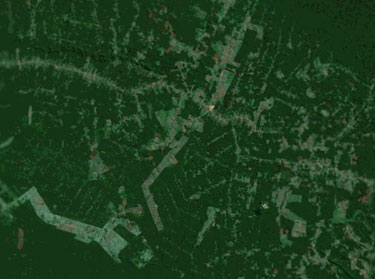Tropical deforestation rates continue to climb
Rhett A. Butler, mongabay.com
January 4, 2006
Tropical deforestation rates continue to climb according to figures released by the Food and Agriculture Organization of the United Nations (FAO).
Analysis of FAO data by mongabay.com shows that tropical deforestation rates increased 8.5 percent from 2000-2005 when compared with the 1990s, while loss of primary forests expanded by almost 24 percent over the same period. Nigeria and Vietnam’s rate of primary forest loss doubled since the 1990s, while Peru’s rate more than tripled.
Annual tropical deforestation rates increased from 0.57 percent to 0.62 percent, while clearing of primary tropical forests rose from 0.66 percent to at least 0.81 percent between the two periods.
Overall, FAO estimates that 10.40 million hectares of tropical forest were permanently destroyed each year in the period from 2000 to 2005, an increase since the 1990-2000 period, when around 10.16 million hectares of forest were lost. Among primary forests, annual deforestation rose to 6.26 million hectares from 5.41 million hectares in the same period. On a broader scale, FAO data shows that primary forests are being replaced by less biodiverse plantations and secondary forests. Due to a significant increase in plantation forests, forest cover has generally been expanding in North America, Europe and China while diminishing in the tropics. Industrial logging, conversion for agriculture (commercial and subsistence), and forest fires — often purposely set by people — are responsible for the bulk of global deforestation today.
In terms of total annual forest loss between 1990 and 2005, Brazil led all countries, losing 2.8 million hectares of forest per year. Indonesia, Myanmar, the Democratic Republic of Congo, and Zambia followed.
 Deforestation in the Brazilian Amazon Courtesy of NASA |
Looking at the percentage area of deforestation over the 15-year period starting in 1990, Burundi lost the largest area of tropical forest with 47% of its forests permanently cleared. Togo, Honduras, Nigeria, and the Philippines followed. Brazil — home to the Amazon, the world’s largest rainforest — lost only about 8.1% of its total forest cover during that time, although at least another 8% of its forest area was degraded by other extractive activities like selective logging and conversion for plantations.
Deforestation is accelerating the fastest in Malaysia where the annual deforestation rate jumped 85.7% between the 2000-2005 period and the 1990-2000 period.
Scientists are concerned that tropical deforestation — especially biologically rich rainforests — is contributing to global warming and causing a mass extinction event not seen since the dawn of civilization.
Deforestation vs. Degradation